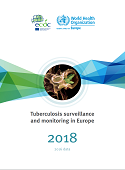Tuberculosis surveillance and monitoring report in Europe 2018

Download
Although the WHO European Region carries only 3% of the global burden of tuberculosis (TB), it has one of the highest proportions of multidrug-resistant TB (MDR-TB). Despite a steady decline in TB burden during last decade, TB remains a public health threat in the Region. In 2016, the Region had 290 000 new TB cases and 26 000 deaths from TB, which is equivalent to 32 and 2.8 per 100 000 population, respectively.
The main challenges faced by the Region are drug-resistant TB and TB/HIV coinfection. While the Region has a relatively high rate of MDR-TB case detection (73%), treatment success among these cases falls below the target (55%), which leads to ongoing transmission.
TB is strongly associated with those conditions that weaken the immune system, like HIV, as well as social determinants such as poverty, unemployment, imprisonment, migration and noncommunicable conditions such as the harmful use of alcohol, diabetes mellitus and tobacco use. TB patients are most frequently young adults in the eastern part of the Region, migrants and native-born elderly people in western Europe.
This report provides an overview of the latest epidemiological situation and the mid-term progress in implementation of the Tuberculosis Action Plan for WHO European Region 2016–2020, and commemorates the 10th anniversary of the Berlin Declaration on Tuberculosis – “All against Tuberculosis”.



